+ Open data
Open data
- Basic information
Basic information
| Entry | Database: PDB / ID: 1lg7 | ||||||
|---|---|---|---|---|---|---|---|
| Title | Crystal structure of Vesicular Stomatitis Virus Matrix Protein | ||||||
 Components Components | VSV matrix protein | ||||||
 Keywords Keywords | VIRAL PROTEIN / VIRUS MATRIX | ||||||
| Function / homology |  Function and homology information Function and homology informationsymbiont-mediated suppression of host transcription initiation from RNA polymerase II promoter / host cell nuclear membrane / viral budding via host ESCRT complex / symbiont-mediated suppression of host mRNA export from nucleus / structural constituent of virion / host cell cytoplasm / viral envelope / membrane Similarity search - Function | ||||||
| Biological species |  Vesicular stomatitis virus Vesicular stomatitis virus | ||||||
| Method |  X-RAY DIFFRACTION / X-RAY DIFFRACTION /  SYNCHROTRON / SYNCHROTRON /  SIRAS / Resolution: 1.96 Å SIRAS / Resolution: 1.96 Å | ||||||
 Authors Authors | Gaudier, M. / Gaudin, Y. / Knossow, M. | ||||||
 Citation Citation |  Journal: EMBO J. / Year: 2002 Journal: EMBO J. / Year: 2002Title: Crystal structure of vesicular stomatitis virus matrix protein. Authors: Gaudier, M. / Gaudin, Y. / Knossow, M. #1:  Journal: Virology / Year: 2001 Journal: Virology / Year: 2001Title: Cleavage of Vesicular Stomatitis Virus Matrix Protein Prevents Self-association and Leads to Crystallization Authors: Gaudier, M. / Gaudin, Y. / Knossow, M. | ||||||
| History |
| ||||||
| Remark 999 | SEQUENCE Author informed that protein sequence under study has not yet been deposited in any ... SEQUENCE Author informed that protein sequence under study has not yet been deposited in any sequence database |
- Structure visualization
Structure visualization
| Structure viewer | Molecule:  Molmil Molmil Jmol/JSmol Jmol/JSmol |
|---|
- Downloads & links
Downloads & links
- Download
Download
| PDBx/mmCIF format |  1lg7.cif.gz 1lg7.cif.gz | 48.8 KB | Display |  PDBx/mmCIF format PDBx/mmCIF format |
|---|---|---|---|---|
| PDB format |  pdb1lg7.ent.gz pdb1lg7.ent.gz | 34.8 KB | Display |  PDB format PDB format |
| PDBx/mmJSON format |  1lg7.json.gz 1lg7.json.gz | Tree view |  PDBx/mmJSON format PDBx/mmJSON format | |
| Others |  Other downloads Other downloads |
-Validation report
| Summary document |  1lg7_validation.pdf.gz 1lg7_validation.pdf.gz | 431.5 KB | Display |  wwPDB validaton report wwPDB validaton report |
|---|---|---|---|---|
| Full document |  1lg7_full_validation.pdf.gz 1lg7_full_validation.pdf.gz | 436.6 KB | Display | |
| Data in XML |  1lg7_validation.xml.gz 1lg7_validation.xml.gz | 11.8 KB | Display | |
| Data in CIF |  1lg7_validation.cif.gz 1lg7_validation.cif.gz | 15.1 KB | Display | |
| Arichive directory |  https://data.pdbj.org/pub/pdb/validation_reports/lg/1lg7 https://data.pdbj.org/pub/pdb/validation_reports/lg/1lg7 ftp://data.pdbj.org/pub/pdb/validation_reports/lg/1lg7 ftp://data.pdbj.org/pub/pdb/validation_reports/lg/1lg7 | HTTPS FTP |
-Related structure data
| Similar structure data |
|---|
- Links
Links
- Assembly
Assembly
| Deposited unit | 
| ||||||||
|---|---|---|---|---|---|---|---|---|---|
| 1 |
| ||||||||
| 2 | 
| ||||||||
| Unit cell |
|
- Components
Components
| #1: Protein | Mass: 21011.041 Da / Num. of mol.: 1 / Source method: isolated from a natural source / Source: (natural)  Vesicular stomatitis virus / Genus: Vesiculovirus / Strain: Indiana - Orsay / References: UniProt: Q8B0H2 Vesicular stomatitis virus / Genus: Vesiculovirus / Strain: Indiana - Orsay / References: UniProt: Q8B0H2 |
|---|---|
| #2: Water | ChemComp-HOH / |
| Has protein modification | Y |
-Experimental details
-Experiment
| Experiment | Method:  X-RAY DIFFRACTION / Number of used crystals: 1 X-RAY DIFFRACTION / Number of used crystals: 1 |
|---|
- Sample preparation
Sample preparation
| Crystal | Density Matthews: 2 Å3/Da / Density % sol: 38.55 % | ||||||||||||||||||||||||||||||||||||||||||||||||||||||||
|---|---|---|---|---|---|---|---|---|---|---|---|---|---|---|---|---|---|---|---|---|---|---|---|---|---|---|---|---|---|---|---|---|---|---|---|---|---|---|---|---|---|---|---|---|---|---|---|---|---|---|---|---|---|---|---|---|---|
| Crystal grow | Temperature: 291 K / Method: vapor diffusion, hanging drop / pH: 8.5 Details: PEG 2000 monometylether, sodium chloride, sodium acetate, Tris, pH 8.5, VAPOR DIFFUSION, HANGING DROP, temperature 291K | ||||||||||||||||||||||||||||||||||||||||||||||||||||||||
| Crystal grow | *PLUS Details: Gaudier, M., (2001) Virology, 288, 308. | ||||||||||||||||||||||||||||||||||||||||||||||||||||||||
| Components of the solutions | *PLUS
|
-Data collection
| Diffraction | Mean temperature: 200 K |
|---|---|
| Diffraction source | Source:  SYNCHROTRON / Site: SYNCHROTRON / Site:  ESRF ESRF  / Beamline: BM30A / Wavelength: 1 Å / Beamline: BM30A / Wavelength: 1 Å |
| Detector | Type: MAR scanner 345 mm plate / Detector: IMAGE PLATE / Date: Sep 17, 1999 |
| Radiation | Monochromator: Si 111 CHANNEL / Protocol: SINGLE WAVELENGTH / Monochromatic (M) / Laue (L): M / Scattering type: x-ray |
| Radiation wavelength | Wavelength: 1 Å / Relative weight: 1 |
| Reflection | Resolution: 1.96→25 Å / Num. all: 210584 / Num. obs: 209741 / % possible obs: 99.6 % / Observed criterion σ(F): 0 / Observed criterion σ(I): 0 / Rsym value: 0.069 / Net I/σ(I): 30 |
| Reflection shell | Resolution: 1.96→2.01 Å / Mean I/σ(I) obs: 3.5 / Rsym value: 0.41 / % possible all: 95.3 |
| Reflection | *PLUS Lowest resolution: 25 Å / Num. obs: 12771 / Num. measured all: 209741 / Rmerge(I) obs: 0.069 |
| Reflection shell | *PLUS % possible obs: 95.3 % / Rmerge(I) obs: 0.41 |
- Processing
Processing
| Software |
| ||||||||||||||||||||||||||||||||||||||||||||||||||||||||||||
|---|---|---|---|---|---|---|---|---|---|---|---|---|---|---|---|---|---|---|---|---|---|---|---|---|---|---|---|---|---|---|---|---|---|---|---|---|---|---|---|---|---|---|---|---|---|---|---|---|---|---|---|---|---|---|---|---|---|---|---|---|---|
| Refinement | Method to determine structure:  SIRAS / Resolution: 1.96→25 Å / Cross valid method: THROUGHOUT / σ(F): 0 / Stereochemistry target values: Engh & Huber SIRAS / Resolution: 1.96→25 Å / Cross valid method: THROUGHOUT / σ(F): 0 / Stereochemistry target values: Engh & Huber
| ||||||||||||||||||||||||||||||||||||||||||||||||||||||||||||
| Solvent computation | Bsol: 44.7872 Å2 / ksol: 0.335821 e/Å3 | ||||||||||||||||||||||||||||||||||||||||||||||||||||||||||||
| Displacement parameters | Biso mean: 29.7033 Å2 | ||||||||||||||||||||||||||||||||||||||||||||||||||||||||||||
| Refinement step | Cycle: LAST / Resolution: 1.96→25 Å
| ||||||||||||||||||||||||||||||||||||||||||||||||||||||||||||
| Refine LS restraints |
| ||||||||||||||||||||||||||||||||||||||||||||||||||||||||||||
| LS refinement shell | Resolution: 1.96→2.03 Å / Total num. of bins used: 10
| ||||||||||||||||||||||||||||||||||||||||||||||||||||||||||||
| Refinement | *PLUS Lowest resolution: 25 Å / Num. reflection obs: 12032 / Rfactor all: 0.218 / Rfactor obs: 0.206 / Rfactor Rfree: 0.241 / Rfactor Rwork: 0.206 | ||||||||||||||||||||||||||||||||||||||||||||||||||||||||||||
| Solvent computation | *PLUS | ||||||||||||||||||||||||||||||||||||||||||||||||||||||||||||
| Displacement parameters | *PLUS | ||||||||||||||||||||||||||||||||||||||||||||||||||||||||||||
| Refine LS restraints | *PLUS
| ||||||||||||||||||||||||||||||||||||||||||||||||||||||||||||
| LS refinement shell | *PLUS Rfactor Rfree: 0.327 / Rfactor Rwork: 0.239 / Rfactor obs: 0.239 |
 Movie
Movie Controller
Controller



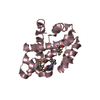
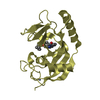

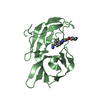
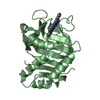
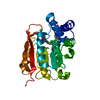
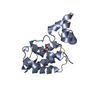
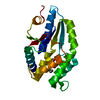


 PDBj
PDBj
